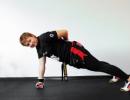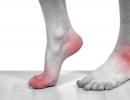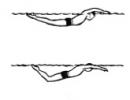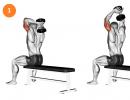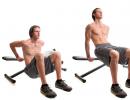Strengthening the press at home. Tighten your stomach at home quickly. The best exercises for the press. Exercises in the gym
Anyone who purposefully visits Gym to form the body of your dreams, they will confirm that the most difficult thing is to pump up a beautiful press that would adorn the relief muscles. The main difficulty lies in the fact that on the way to the cherished dream there are always fat accumulations in this part of the body.
However, even small amounts of deposits can significantly spoil the picture. Therefore, setting out to become the owner of a relief press, you need to remember that a lot also depends on nutrition. But in the conditions of correcting the daily diet, special exercises to strengthen the press will help to achieve the intended .
As already mentioned, strengthening the abdominal muscles through regular training will have an obvious result only if the fat deposits in this area are kept to a minimum. To do this, it is imperative to adjust the daily diet, replacing fatty, fried and sweet foods with protein and fiber.
Special exercises will also help to achieve the intended results faster:
- The simplest and most famous exercise for burning calories and strengthening muscles is considered to be the “cyclist”, which involves imitating the corresponding movements with the legs. You can perform this exercise both in a sitting and lying position.
- Straight leg raise. Both sitting and lying position are also suitable for this exercise.
- An exercise called "scissors". It's hard to find someone who doesn't know school years with this exercise, for which you should lie on the floor and alternately cross straightened legs among themselves, holding them in weight.
- This exercise consists in a consistent change of position. So, first you should lie on the floor, then take a sitting position, bending your legs, and return to the starting position.
- You need to take a starting position, kneeling, and begin to reproduce the tilt back. At the same time, it is important to ensure that hip joints were in an open position.
- It is necessary to lie on your stomach, and then begin to reproduce the actions to raise the abdominal wall. While lifting, be sure to linger for 5 seconds.
- For the starting position, you should get on all fours. The exercise involves retracting the abdominal wall with a slight arching of the back. Stay in this position for at least 5 seconds. After that, you need to relax and repeat the exercise.
- You should lie on your back and put your arms bent at the elbows behind your head. After that, it is necessary to simultaneously raise the head and shoulders, holding in this position for about 5 seconds. After a short relaxation, the exercise must be repeated.
Each of the exercises is quite effective, but the results will be visible only in conditions of regular training. Each of the exercises is recommended to be repeated about 15 times.
Strengthening the abdominal muscles can be done and not only during training. For example, throughout the day, you should periodically retract the abdominal wall, repeating the steps at least 5 times.
Strengthening the abdominals: exercises
The complex of the following exercises is aimed directly at forming a relief press. Strengthening the abdominal muscles can also be achieved with the help of walking and running, which involves high hip lifts, bending and raising the lower limbs.
Muscle strengthening abdominals provide the following exercises:
- To take the starting position, you need to stand with your feet shoulder-width apart, after which you should slowly bend forward, trying to touch the floor with your fingertips. It is necessary to monitor the position of the knees, which are strictly forbidden to bend. Ten repetitions are enough to get the proper result.
- The starting position is the same, and the exercise involves alternately raising the straightened legs forward. At the same time, both hands should be extended, trying to touch the toes with the toes.
- To perform this exercise, you need to lie on your back, and your arms should be spread apart so that your palms touch the floor. Straightened legs should be slowly lifted up and tilted behind the head, touching the floor with your fingers. It is recommended to repeat the exercise no more than 5 times.
- It is necessary to lie on the floor and bend your knees, resting your feet on the floor. The arms should be extended along the body. The exercise consists in raising the head so that the chin is as close to the chest as possible. At the same time as the head, it is necessary to raise your hands and alternately reach out right hand to the right foot and left to the left. It is necessary to ensure that during the exercise the shoulders are also slightly raised.
Conclusion!
The above exercises aimed at strengthening the press are considered simple and at the same time effective. A video about the phased implementation of each exercise will allow you to avoid many mistakes and achieve the intended results on the way to the figure of your dreams.
Video about ways to pump up the press for beginners
Now let's talk about better ways how to strengthen abdominal muscles. Strong belly with muscle contour is the dream of many women and men. This is the calling card of people who care about their appearance and are not afraid strong exercises. Although exercise is very important, an appropriate diet is essential. It will allow you to get rid of the layer of fat, which will lead to the fact that the muscles will become visible.
Time for training
When the appropriate programs for a healthy and balanced diet have already been established, it's time to start training. Each workout of the abdominal muscles should be preceded by a warm-up, which will prepare the muscles for work. Worth a few exercise such as hip rotation, torso twists, jumps, bends, jumping rope. Aerobic exercises should be carried out to help raise the temperature in the muscles.
Abdominal training can be a block of its own, but it's much better when you combine it with running or cycling. The great advantage of such training is the possibility of carrying it out without a large number equipment. To get started, use a simple exercise mat. Over time, you can assemble exercise machines with a load that will give even better results.
Abdominal training is a fairly complex procedure and should not be done every day. After light workout intensity is worth taking a 2 day break. At this time it is worth doing another party muscle mass. Regeneration time is very important, it helps to keep the muscles in shape and not lead to overtraining.
How to prepare for a workout
The tracksuit is the foundation. It is more convenient to perform exercises in leggings, shorts and a T-shirt made of the appropriate material. For starters, a mat and a list of exercises are enough. Over time, you can start practicing additional loads. It is worth introducing new elements into training, then they will be more effective. The main load is dumbbells, which are well suited for other workouts.
Good idea - gymnastic ball , which is an ideal equipment for training abdominal muscles, squats, inclines and other exercises. It's good to have a hula hoop and a training circle on hand. The last device strengthens the muscles of the abdomen, arms, back and chest. It also improves physical fitness.
A few simple exercises
Repeat the exercise in two sets of 25-30 times. Over time, add others, change them to exercises with a load. Variety in training is important. This is very simple exercises, and you can safely perform them at home.
1. Lie on the mat, bend your knees and place your feet parallel to each other. Weave your hands behind your head. Exhale as you lift your shoulders and chest. The head is always in the continuation of the spine.
2. Lie on the mat, lift your legs up, bend your knees at a right angle and interlace your legs. Weave your hands behind your head. Raise your shoulders off the mat. Just like in the previous exercise, follow the zone cervical spine.
3. Lie on your back, raise your legs to a 90-degree angle, and bend your knees slightly. Raise your head and torso up, extending your arms towards your legs, and then return to the supine position. The legs remain at the top throughout the exercise.
4. Exercise for the development of oblique muscles. Lie on your back, bend your knees and place your feet on the mat. Weave your hands behind your head. Lifting your shoulders off the floor, turn your torso, first to the right, and then to the left.
5. Take a lying position. Hands should be in line with the shoulders, and the body should form a straight line. It is necessary to alternately pull the bent leg to the chest. Perform movements slowly and precisely to feel the work of the abdominal muscles. During training of the abdominal muscles, it is very important to control the lumbar spine. If you feel pain, stop exercising.
We have described simple ways how to strengthen the abdominal muscles without much effort. The main thing is not to wait for a quick effect, you need to do it systematically, and for several months.
The main function of muscles is movement and stabilization. The spine is held by the muscles of the back from behind, and by the muscles of the abdomen - from the front. This is an important, highly developed and compensatory mechanism of our body. Weakness of the abdominal muscles is one of the first causes of pain not only in the abdomen and groin, but also in the back.
Understandable simple exercises will help restore abdominal muscles after operations, injuries and prolonged immobilization.
Clothing should be loose, shoes should be removed. All exercises (especially the first days) should be performed smoothly and gradually. Remember the important principle: "Tolerate mild pain, do not allow severe pain."
Do these exercises daily for at least 2 weeks.
Lying on your back, legs bent at the knees, arms along the body. Try to draw in your stomach as much as possible and pull your navel towards the spine. Hold this position for 15 seconds and then relax. Repeat 5-10 times.

Lying on your back, legs bent at the knees, arms along the body. Pull your belly button in the direction of your spine, pressing your lower back into the floor, keeping your spine as straight as possible. Hold this position for 15 seconds and then relax. Repeat 5-10 times.

Lying on your back, legs bent at the knees, arms along the body. Tighten your abdominal muscles. While holding the tension, lift one bent leg, a few centimeters from the floor and hold it for 5 seconds, then lower it. Repeat the exercise with the second leg. Then raise your hand above your head and hold it for 5 seconds. Then lower and repeat the exercise with the second hand. Repeat 5 times with each arm and leg.
As soon as the exercise is no longer difficult for you, start raising your leg and the opposite arm at the same time. Hold also for 5 seconds. 3 sets of 5 reps on each side.

Lying on your back, legs bent at the knees, arms along the body. Straining the abdominal muscles, we tear off the shoulder blades from the floor and stretch our arms in the direction of the legs. Hold the reached position for 3 seconds. Don't hold your breath. 2 sets of 15 reps. If you clasp your hands in a lock behind your head, and spread your elbows to the sides, the effectiveness of the exercise increases significantly.
Start doing the following exercises when you get used to the previous ones. Recommended 1 week after the start of classes.

Lying on your back, legs bent at the knees, arms along the body. Straining the abdominal muscles, we tear off the shoulder blades from the floor and stretch our arms in the direction of the legs, turning the body to the right. Hold the reached position for 3 seconds. Do not hold your breath, do not help yourself with your hands. Then return to the starting position. Repeat the exercise 15 times on each side. 2 sets of 15 reps. If you clasp your hands in a lock behind your head, and spread your elbows to the sides, the effectiveness of the exercise increases significantly.
Exercise number 1: body lifts.
The purpose of the exercise: the development of the upper section of the rectus abdominis muscles.
Performance:
1) Lie on your back on the floor and put your legs on the bench in front of you, bending them at the knees. You can put your hands behind your head or keep them in front of your body, whichever is more comfortable (fig. 1).
2) Bend your torso towards your knees, arching your back. Don't try to lift your entire back off the floor, just lean forward and bring your chest close to your pelvis. At the top of the movement, specifically tighten your abdominal muscles to achieve a full contraction, then relax and lower yourself to the starting position. This movement should be performed slowly, under full control.
You can change the angle of the load on the abdominal muscles by changing the height of the bench. Instead of a bench, try resting your feet against a wall at whatever height you feel comfortable with.
Figure 1 - Hull lifts
Exercise number 2: lifting the body with a turn.
The purpose of the exercise: the development of the upper abdominal and oblique muscles of the abdomen.
Performance:
1) Lie on your back on the floor and put your legs on the bench in front of you, bending them at the knees (Fig. 2).
2) Put your hands behind your head and bend your torso towards your knees, arching your back. At the same time, bend your torso to the side so that your right elbow goes to your left knee. Relax and return to the starting position.
3) Repeat the twisting movement in the opposite direction so that the left elbow goes to the right knee. Continue alternating movements until the end of the series.

Figure 2 - Body lifts with rotation
Exercise number 3: twisting on a Roman chair.
The purpose of the exercise: emphasizes the load on the upper rectus abdominis muscles.
Performance:
1) Sit on a Roman bench, put your feet under the support and put your hands in front of you (Fig. 3).
2) Keeping your stomach in, lower yourself at an angle of about 70°, but not parallel to the floor. Rise to the starting position and bend your torso forward as far as possible, feeling the contraction of the rectus abdominis muscles.
You can experiment by lifting the front of the Roman bench to create an incline and increase the intensity of the exercise. This exercise can also be done with variable resistance by starting on an elevated bench and then, when you start to get tired, lower it to the floor and continue the series.

Figure 3 - Twisting on a Roman chair
Exercise number 4: reverse twists.
Execution: This exercise is best performed on a bench press bench with a rack at one end.
1) Lie on your back on the bench, stretch your arms back and grab the counter or the edge of the bench for balance. Bend your knees and raise them as high as possible without lifting your pelvic region and lower back from the bench (Fig. 4).
2) From this position, raise your knees even higher and pull them as close to your face as possible, arching your back and bringing your pelvis closer to your chest. Hold for a second at the end of the movement and specifically tighten the abdominal muscles to achieve their full contraction. Slowly lower your knees until your tailbone touches the bench (don't lower your legs, otherwise the exercise will turn into a type of leg raise).
Repeat this movement slowly and under complete control.

Figure 4 - Reverse twists
Exercise number 5: grouping on a horizontal bench.
The purpose of the exercise: the development of the upper and lower section abdominal press.
Performance:
1) Sit on a bench and grasp its edges for balance. Raise your legs slightly, bend them at the knees and lean back at an angle of approximately 45° (Fig. 5).
2) In a counter-movement (sometimes referred to as the “scissor torso curl”), bend your torso forward, arching your back, and at the same time pull your knees up to your chin. Feel the contraction of the abdominal muscles as the chest and pelvic region converge. Then return to the starting position.

Figure 5 - Grouping on a horizontal bench
Exercise number 6: turning the torso in a sitting position.
Performance:
1) Sit on the end of a bench with your feet flat on the floor and your legs slightly apart. Put a broom stick or a light metal rod on your shoulders and grasp its ends (Fig. 6).
2) Keeping your head still, turn your torso sideways as far as you can. Hold on for a second extreme point movement, then turn your torso to the other side. The movement should be smooth, without jerks and swaying. Since this exercise contracts the obliques, but is performed without weights, it compacts the muscles, but does not increase their volume, which can visually expand the waist area.

Figure 6 - Turns of the body in a sitting position
Exercise number 7: standing bends with the rotation of the torso.
The purpose of the exercise: compaction of the oblique abdominal muscles.
Performance:
1) Stand with your legs slightly apart, put a broomstick or a light metal rod on your shoulders and grasp its ends. Then lean forward from the waist (Fig. 7).
2) Keeping your head still and without rotating your pelvis, turn your torso sideways as far as you can. Hold for a second at the extreme point of the movement, then turn your torso to the other side. The movement should be smooth, without jerks and swaying.

Figure 7 - Standing tilts with torso rotation
Exercise number 8: reverse twisting on an incline bench.
The purpose of the exercise: the development of the lower abdomen.
Performance:
1) Lie on your back incline bench so that the head is higher than the legs. Stretch your arms and grasp the top edge of the bench for balance (fig. 8).
2) Raise your legs with bent knees as far as you can, then lower them, stopping the moment your tailbone touches the bench. Breathe in as you lift up and breathe out as you lower your legs.

Figure 8 - Reverse crunches on an incline bench
Exercise number 9: leg raises on a horizontal bench.
The purpose of the exercise: the development of the lower abdomen.
Performance:
1) Lie on your back on a flat bench so that your buttocks are at the very edge of the bench. Grasp the edge with your hands for balance and stretch your legs forward (fig. 9).
2) Keeping your legs straight, lift them vertically. Pause, then lower your legs just below the level of the bench.

Figure 9 - Leg raises on a horizontal bench
Exercise number 10: lifting the body to bent legs on the side.
The purpose of the exercise: the development of oblique abdominal muscles.
Performance:
1) Lying on your back, bend your knees and place them to the right. Put your hands behind your head, relax your neck (Fig. 10).
2) Using the left oblique abdominal muscles, lift the shoulder blades off the floor and lift the chest towards the pelvis. Hold on for a second. Then slowly and carefully return your shoulders to their original position. As soon as your shoulder blades touch the floor, repeat the exercise. When you have completed the required number of repetitions on the left side, switch position and work the right side. Perform the same number of repetitions on the right side as on the left.

Figure 10 - Raises the body to bent legs on the side
Exercise number 11: side leg raises.
The purpose of the exercise: for the oblique muscles of the abdomen and intercostal muscles. This exercise develops the side of the torso and visually reduces your waist.
Performance:
1) Lie on your side and lean on your elbow, slightly bending lower leg in the knee (Fig. 11).
2) Keeping your top leg straight, slowly lift it up as high as you can, then lower it, but don't touch the floor. When you finish with one leg, turn to the other side and repeat the exercise.

Figure 11 - Lateral Leg Raises
Exercise number 12: swing your legs on your side.
Purpose of the exercise: For the oblique muscles of the abdomen and intercostal muscles.
Execution: This exercise starts from the starting position for lateral leg lifts (Fig. 12). However, here you are slowly bringing your top leg forward as far as possible. The leg should remain straight from the beginning to the end of the movement. When you finish the exercise, turn to the other side and work with the other leg.

Figure 12 - Swing legs on the side
Exercise number 13: Abdominal retraction ("Vacuum").
The purpose of the exercise: the development of the ability to fully control the abdominal muscles, as well as the development of their relief.
Execution: To perform the "vacuum", get on all fours, exhale all the air from the lungs and draw in the stomach as much as you can (Fig. 13). Hold this state for 20-30 seconds, then relax for a few seconds and try two or three more times.
The next step is to practice the "vacuum" while kneeling. Straighten up with your hands on your knees and try to hold the "vacuum" for as long as you can.
Performing a "vacuum" in a sitting position is an even more difficult task. But once you can hold the "vacuum" while sitting without too much trouble, you will be able to do it while standing in various postures.

Figure 13 - Abdominal retraction
Exercise number 14.
The purpose of the exercise: strengthening the upper and lower parts abdominal press.
Performance:
1) In the supine position, spread your elbows to the sides and close your hands behind your head. Bend your legs at the knees at an angle of ninety degrees, press your feet firmly to the floor.
2) Raise upper part torso and leg bent at the knee, and do it at the same time.
3) Reach your elbows up to your knee using both your upper and lower abdominals. Hold this position for two seconds, and then slowly return to the starting position. Change your leg after each lift.
Exercise number 15.
The purpose of the exercise: strengthening the upper part of the abdominal press.
Performance:
1) Lie on your back and pull in your stomach, clasp your hands behind your head, spread your elbows to the sides. Bend your knees at a ninety degree angle so that the soles are firmly pressed to the floor.
2) While contracting the abdominal muscles, slightly lift the upper body, maintaining the original position of the hands.
3) Hold your body upside down for about two seconds, and then slowly return to the starting position.
These exercises develop all the abdominal muscles. Exercises No. 10, No. 11, No. 12, No. 14, No. 15 were used in shaping classes.
Fat deposits in the abdomen are a concern for many women. Who would not want to make the waist thinner and more expressive?! Yes, each! But at the same time, few people know how to properly approach the strengthening of the muscles in the abdominal area and not increase their volume.
Consider a technique that will help you lose weight in the area you need - the stomach. This technique is real exercises for the abdominal muscles at home. But before you use them, you need to know how much fat to reduce ... How to calculate whether you need to get rid of extra centimeters on your stomach?
All you have to do is divide your waist by your hips. It is best if the indicator is about 0.7. If it is above 0.8, then you should definitely take care of yourself and drive off fat, using both diet and exercise for this.
It is believed that each person is unique, so it is impossible to choose a universal diet that is suitable for everyone. Most of the hyped bizarre diets promote weight loss by removing fluid from the tissues and reducing muscle mass.
Firstly, such products contain a minimum amount of fat, and secondly, due to their high fiber content, they help cleanse the body of decay products accumulated in it and regulate metabolic processes.
Very an important factor is a physical activity aimed at all muscle groups. With the right effort, you can make the most dangerous deep fat melt. The most common exercises will help you with this, which will make not only the abdominal muscles work, but also others.
In order to tidy up the waist, you can not do without special exercises that will help strengthen weak abdominal muscles. After all, such a disadvantage, in addition to external unattractiveness, is fraught with a more serious danger.
Due to the weak muscles of the press, the omission of some internal organs, and the normal functioning of the gastrointestinal tract may also be disrupted.
In order to tighten the muscles, you don’t need so much, someone may well have enough constant control over the position of the body - the shoulders should be straight, the chest should be straightened, and the stomach should be as retracted as possible.
After some time, the muscles get used to being constantly in a tightened position. If overweight too much, then reduce it, simultaneously increasing physical activity.
If you devote at least fifteen minutes a day to the general set of exercises and fifteen minutes to load the press, the results will begin to appear fairly quickly.
Position your feet shoulder-width apart, slightly bending your knees (to maintain balance), stretch your arms in front of you at shoulder level. Sharply turn the upper body to the right and left, while the lower half should remain motionless. Do four to six repetitions on each side.
Repeat the previous exercise, making it more difficult. Turning to the right, pull your left knee as close to your chest as possible. Accordingly, when turning left - right.
Lie on your back, stretch your arms behind your head, and bend your knees. When lifting the body, pull your hands to the feet, lowering, fold them crosswise on the chest. Repeat from five times.
In any position of the body, inhaling, draw in the stomach as much as possible, and, exhaling, relax. Repeat ten times.
Lie flat on your back and breathe deeply into your belly. When inhaling, try to push your stomach out harder, and when you exhale, pull it in.
A set of exercises aimed at strengthening the abdominal press:
Lie on the floor and spread your arms out to your sides. Pull the legs bent at the knees to the chest, then straighten them;
Place your arms along, near the body, then raise your legs, gradually straightening them to a vertical position. Then lower them down;
Make scissors movements in different directions - up and down, right and left;
Sit down, helping yourself a little with your hands, then lie back down;
Sit down, no longer using your hands, reach your feet with your hands, without bending your knees, at this time stretch your forehead towards them;
Lie straight, rising, stretch your left elbow to your right knee.
Then repeat vice versa;
Raise your legs sharply and at the same time along with the upper half of the torso. Colloquially, such an exercise is called a "jackknife";
Raise and straighten your legs, performing a "half-cut";
Perform "bike";
Raise your legs slightly and move them to the right and left;
Rise off the floor and lean on your feet and palms. Now rotate the pelvis, then dropping as low as possible, then rising as high as possible;
Slowly raise your legs 20 cm off the floor and keep them in this position for as long as possible;
Lie on your stomach and roll to the right, then to the left;
From the same position, extend your arms along the body, turning them down with your palms. Gently rise, while leaning on your socks and palms;
Also lying on your stomach, raise your legs and head, then, bending over, stretch your arms forward. Freeze for as long as possible.
With regular repetition of the proposed complex, you can put your waist in order. The above exercises for the abdomen can vary and become more difficult depending on your fitness and desire.


